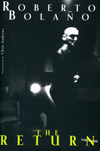The Return
If you’re reading this review, on this website, you probably know who Roberto Bolaño is/was. You know he died at age 50, likely due to complications from drug and alcohol addictions. You know he was a poet who switched to fiction to support his family. You’ve probably read at least one of his two major works, The Savage Detectives and 2666, and probably a couple of the shorter works like Amulet, Antwerp or Last Evenings on Earth.
If you’re reading this review, on this website, you probably know who Roberto Bolaño is/was. You know he died at age 50, likely due to complications from drug and alcohol addictions. You know he was a poet who switched to fiction to support his family. You’ve probably read at least one of his two major works, The Savage Detectives and 2666, and probably a couple of the shorter works like Amulet, Antwerp or Last Evenings on Earth.
The question is, does The Return capture a significant portion of the virtuosic performance Bolaño exhibited in 2666? The answer is, in many ways, yes.
Bolaño tells his stories in such a way that one is convinced no telling of the story could tell the whole story as he has imagined it. Details are obscured by the narrator’s limited perspective. Time passes fluidly, at variable speeds. Often, he writes great portions of his stories in summary; sometimes, he summarizes so much that one feels he may have simply written an outline for a story and left it at that. However, the reader always ends up engrossed in a scene of incredible detail and imaginative force.
These scenes often bear the weight of transparent but nonetheless potent metaphors. For example, in “Another Russian Story,” a Spaniard finds himself being tortured by Russians who believe him to be a German SS soldier. When they begin tearing out his tongue, he screams the Spanish word coño, meaning “cunt,” which they take for the German word Kunst, meaning “art.” The Russians assume he is an artist, not a soldier, and let him live. The misinterpretation can be read several ways, but that a panicked vulgarity – taken for art – saves the Spaniard’s life places the reality of panic and the reality of vulgarity above the artifice of art.
Other mysteries of reality play a large role in the stories found in The Return. In the titular story, the narrator is surprised to find that life after death consists of an out-of-body experience of the soul exactly as it is portrayed in the movie Ghost. “I thought it was idiotic. A typical Hollywood cop-out, inane and unbelievable. But when my turn came, that is exactly what happened,” the unnamed narrator tells us. The narrator then watches his lifeless body become the subject of a necrophiliac romance, which the reader is surprised to find touching and honest. In Bolaño’s world, necrophiliacs are people too.
One noticeable difference between this collection and Last Evenings on Earth is the decidedly drastic uptick in graphic sexuality. “Joanna Silvestri” is the story of a porn star’s relationship with Jack Holmes (clearly a stand-in for John) after he has contracted AIDS. “The Prefiguration of Lalo Cura” (the same Lalo Cura as in 2666?) is about a porn actor (not Lalo) who is not physically gifted in any way, but whose “vibrations” – it is unclear what is meant by this – make him thrilling to observe. The vivid accounts of sexual acts in these stories are at times erotic, at times amusing, and tend to contain the kind of human observations that make Bolaño’s fiction so crushingly endearing.
Then, however, there is the less-than-thrilling story, “Murdering Whores.” A young woman kidnaps a young man she sees celebrating after a soccer game in order to tie him up, torture him and to tell him things like, “The tears seem to be dripping from the ceiling. It doesn’t matter. The way things are, they might as well be spurting out the end of your dick.” This is a rare moment of cheap, antagonistic excess.
Bolaño’s language and his capacity for metaphor remain outstanding. Consider this passage from “Meeting with Enrique Lihn,” in which Bolaño, who plays the role of narrator, dreams of meeting the author with whom, in life, he had a correspondence:
And at that moment, I knew that Lihn knew he was dead. My heart’s given up on me, he said. It doesn’t exist anymore. Something’s not right here, I thought. Lihn died of cancer, not a heart attack. An enormous heaviness was coming over me. So I got up and went to stretch my legs, but not in the bar; I went out into the street. The sidewalks were gray and uneven and the sky looked like a mirror without a tain, the place where everything should have been reflected but where in the end, nothing was.
Though The Return may disappoint those looking for evidence that Bolaño’s well was so deep that every single thing he wrote revealed new realities, it has many touching moments and highlightable passages, and a handful of stories that will give one lengthy pause.





